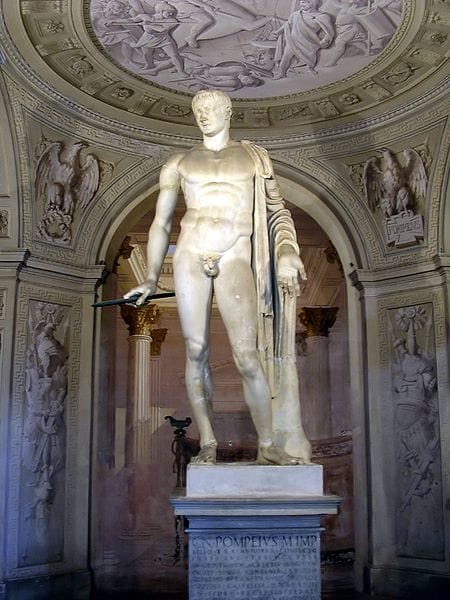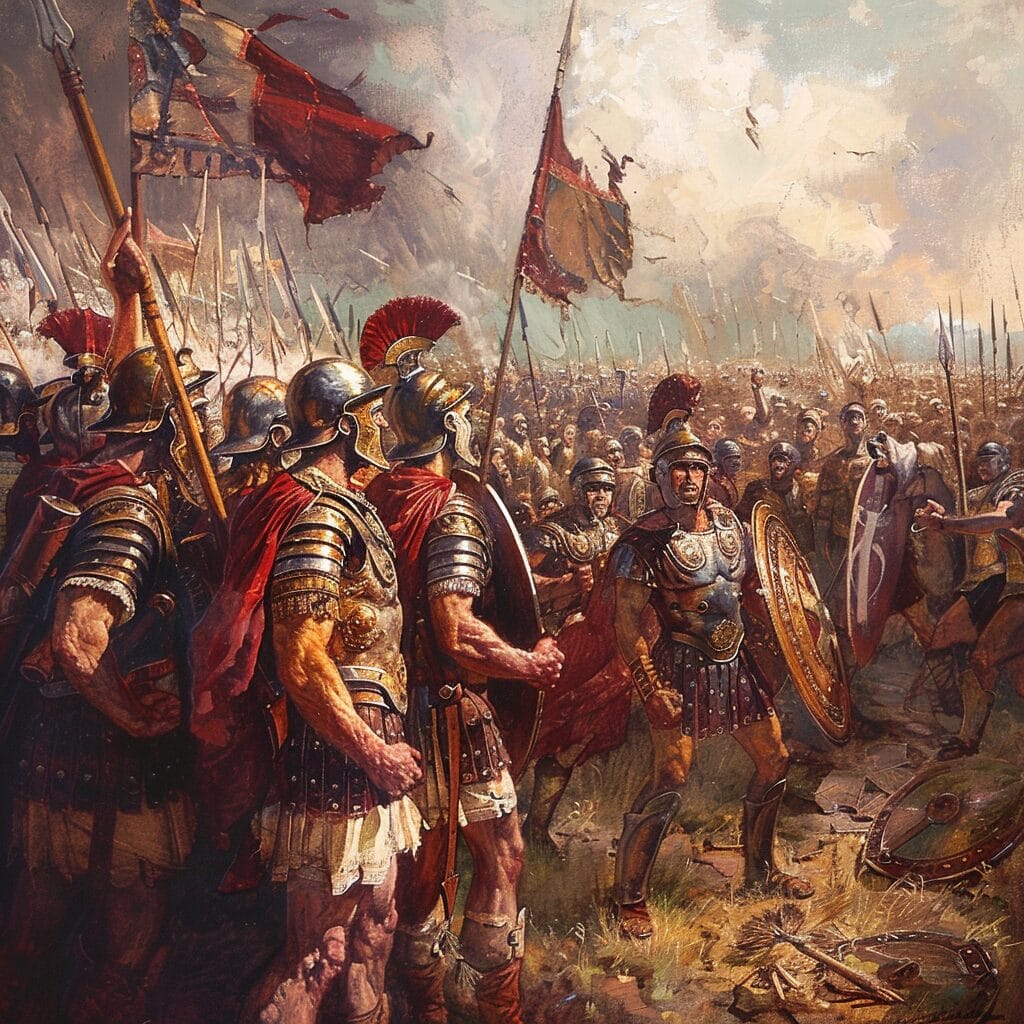Pharsalus marks the site of a pivotal battle in ancient times. In 48 BC, two of Rome’s most formidable leaders, Julius Caesar and Pompey the Great, clashed in Greece near the city of Pharsalus.
Their encounter was a significant episode in the broader saga of the Roman Republic’s internal conflicts, known as the Roman Civil Wars. The battle did not only determine the fates of these leaders but also heralded a transformative period for Rome, shifting it from republic to empire.

The confrontation at Pharsalus was a culmination of escalating tensions and rivalries between Caesar and the Roman Senate, who supported Pompey. This decisive conflict resulted from a complex series of events that included legal disputes, political maneuvering, and Caesar’s controversial crossing of the Rubicon, which in itself was a metaphorical point of no return. But not just metaphorical, since it wasn’t allowed to cross that river with an army.
The repercussions of the battle resonated through the annals of history, influencing Rome’s political landscape and the legacy of its principal figures.
Key Takeaways
- Pharsalus was the decisive battle between Julius Caesar and Pompey the Great in 48 BC.
- The outcome had long-lasting effects on the structure of Roman governance, leading to the empire era.
- The event’s historical significance is underscored by extensive accounts and analysis from ancient times to modern scholarship.
Historical Context
The battle of Pharsalus in 48 BC was a decisive confrontation that reshaped the Roman world, pitting Julius Caesar against Pompey the Great amidst a deeply fractured Roman Republic.
Rise of Julius Caesar
Julius Caesar’s ascent to power began in Cisalpine Gaul, where his military success during the Gallic Wars earned him fame and the loyalty of battle-hardened legions. During the Gallic Wars (58–50 BC), Rome sought to subjugate the Gallic tribes and expand its territories beyond the boundaries of the Roman Republic. The distinction between Cisalpine Gaul, the area on the Italian peninsula south of the Alps, and Transalpine Gaul, the region north of the Italian Peninsula, became a focal area of conflict. It was Julius Caesar who led the Roman legions into these territories, pushing the frontier of Roman influence deep into what is modern-day France.
His political career was marked by strategic alliances, including the formation of the First Triumvirate with Pompey and Crassus. However, Caesar’s refusal to give up his command when ordered by the Senate led to escalating tensions, effectively crossing the Rubicon into a state of conflict with Rome.
Pompey the Great and the Roman Republic
Pompey the Great, renowned as a military and political leader in Rome, was a key figure during a period of intense political maneuvering within the Roman Republic. He aligned with the Senate’s conservative Optimates faction against Caesar.

As a Triumvir and former ally of Caesar, Pompey’s break from Caesar was emblematic of the factions vying for control of Rome and its territories. He sought to preserve the traditions of the Republic against what he viewed as Caesar’s ambition, culminating in the Pompeian Senate’s decision to levy troops in Greece, Hispania, and Syria to counter Caesar’s moves towards Rome.
The Prelude to Battle
In the tense atmosphere preceding the famous Battle of Pharsalus, Julius Caesar’s strategic movements and the territorial maneuverings of both factions set the stage for what would be a crucial confrontation in Roman history.
Caesar’s Civil War
Julius Caesar crossed the Rubicon River in 49 BC, an act that marked the point of no return in his struggle against the Roman Senate and its champion, Pompey. This bold move, often encapsulated by the phrase “The die is cast,” began the Roman civil war that confronted Caesar’s legions against those of Pompey.
Caesar’s advance pushed through Italia swiftly. The critical northern town of Corfinium fell, leading Pompey to retreat to Brundisium and eventually across the Adriatic to the safety of the Balkans. Caesar, exploiting his influence and the loyalty of his veterans, staunchly pursued the senatorial forces, consolidating his control over Italy.
Campaign in the Balkans
The campaign in the Balkans proved to be a crucial prelude to the Battle of Pharsalus. After regrouping, Pompey’s sizeable army posed a formidable challenge to Caesar, who managed to ferry his troops across the Adriatic amidst the winter season’s hostility.
Macedonia became the theater of war, with Caesar’s lieutenant, Domitius Calvinus, holding a position in the region. The standoff at Dyrrachium (modern-day Albania) was instrumental – both generals engaged in a series of maneuvers that tested their military acumen.
Although Caesar suffered shortages and was tactically bested at times, the retreat from Dyrrachium led both armies to the plains near Pharsalus in a strategic attempt to force a conclusive engagement.

The Battle of Pharsalus
On August 9, 48 BC, the Battle of Pharsalus, a decisive engagement of the Great Roman Civil War, saw Julius Caesar’s forces outmaneuver and defeat Pompey’s larger army in Thessaly, near the Enipeus River.
Military Strategies
Caesar’s forces, adept in the art of war, consisted of both veteran legions and auxiliary troops. The deployment of his troops was strategic, with infantry at the core, flanked by cavalry, archers, and slingers.
Remarkably, Caesar placed some cohorts in reserve to counteract Pompey’s formidable cavalry. His second-in-command, Mark Antony, was integral to leading the left wing of Caesar’s army. Pompey’s strategy hinged on using his superior cavalry to flank Caesar’s forces.
His army, commanded by generals like Scipio and Titus Labienus, was reinforced with infantry, legionaries, archers, and slingers. He believed his numerical advantage in cavalry would translate into a swift victory.
Critical Engagements
The main clash occurred as Pompey’s cavalry advanced, attempting to outflank Caesar’s right wing. In response, Caesar’s reserves, light infantry equipped with javelins, were ordered forward, and they managed to repel the cavalry attack.
This allowed Caesar’s infantry to close in, engaging Pompey’s troops in fierce combat where swords clashed amid the cries of battle. The turning point was marked by the meticulous coordination of Caesar’s legionaries and auxiliaries, leading to heavy casualties on Pompey’s side, which compelled a retreat.
Aftermath of the Conflict
The Battle of Pharsalus had far-reaching impacts on the Roman Republic, particularly affecting the lives and trajectories of Pompey the Great and Julius Caesar. It marked the crucial moment of Caesar’s ascension and Pompey’s tragic downfall.
Pompey’s Flight and Assassination

Source: Dguendel, CC BY 3.0 https://creativecommons.org/licenses/by/3.0, via Wikimedia Commons
After his defeat at Pharsalus, Pompey the Great fled to Egypt, seeking asylum under the protection of young Ptolemy XIII. His arrival in Egypt, however, led to his untimely end. In a desperate bid to curry favor with Caesar, Ptolemy XIII ordered Pompey’s assassination. Pompey was killed on September 28, 48 BC, as he stepped ashore at Pelusium, with his death marking the end of an era for Rome.
Caesar’s Consolidation of Power
In the wake of the conflict, Julius Caesar emerged as the unchallenged leader of Rome. Pursuing Pompey to Egypt, Caesar instead found himself entangled in the country’s internal strife, allying with Cleopatra in her civil war against her brother Ptolemy XIII. Following a period of tumult in Egypt, Caesar consolidated his power upon returning to Rome.
He was declared dictator for life, a title that gave him unprecedented control over the Roman state. Caesar’s relentless pursuit of power transformed the fabric of Roman governance, effectively ending the Republic and setting the stage for the emergence of the Roman Empire.
Legacy and Historical Significance
The Battle of Pharsalus also had profound effects on military strategy and the structure of Roman society.
Roman Civil Structure
The Battle of Pharsalus was an important moment in the Roman Republic, where Julius Caesar defeated Pompey’s forces. This victory effectively dismantled the political power of the Optimates, the conservative faction that held sway in the Roman Senate.
It emboldened Caesar to further entrench his control, paving the way for the transformation of the republic into a de facto autocracy under his rule. The traditional checks and balances of Roman governance were supplanted, illustrating a shift in the Roman civil structure as individual authority began to overshadow republican institutions.
Influence on Military Tactics
The impact of Pharsalus extended to Roman military tactics as well. Caesar’s ingenious strategies included the use of reserve cohorts to repel Pompey’s cavalry. These maneuvers not only secured his victory but also influenced subsequent military tactics.
Commanders studied and emulated his approach to warfare. The principles of flexibility, reserve forces, and strategic ingenuity became hallmarks that shaped future battles and military doctrines. Through these facets, the battle not only marked the zenith of Caesar’s political career and his rise to dictatorial power but also cemented his militaristic legacy.
Key figures such as Marcus Junius Brutus were also participants in the civil conflict, underscoring the lasting personal and political reverberations of Pharsalus. Moreover, the breakdown of the First Triumvirate and the ensuing civil war set a precedent for the violent and turbulent power struggles that would characterize the late Roman Republic.
People Also Ask:
Who emerged victorious in the Battle of Pharsalus?
Julius Caesar claimed victory in the Battle of Pharsalus, defeating the forces led by Pompey the Great.
What were the tactics employed during the Battle of Pharsalus?
Caesar made strategic use of his infantry, arranging them into a unique formation that countered Pompey’s reliance on cavalry. Meanwhile, Pompey’s tactics hinged on overwhelming Caesar’s flanks with his numerically superior cavalry.
Can you provide a summary of the Battle of Pharsalus?
The Battle of Pharsalus occurred on August 9, 48 BC, as a decisive confrontation of the Roman Civil War where Caesar’s tactical ingenuity led to a significant defeat of Pompey’s army, despite being outnumbered.
How is ‘Pharsalus’ correctly pronounced?
‘Pharsalus’ is correctly pronounced as /ˈfɑːrsələs/.
What is the present-day location of the ancient site known as Pharsalus?
The ancient site of Pharsalus is located near the modern town of Farsala in central Greece.
What was the number of casualties in the Battle of Pharsalus?
Historical records suggest that Pompey’s forces suffered approximately 6,000 casualties. Meanwhile, Caesar’s casualties were significantly fewer, numbering around 1,200.
Hello, my name is Vladimir, and I am a part of the Roman-empire writing team.
I am a historian, and history is an integral part of my life.
To be honest, while I was in school, I didn’t like history so how did I end up studying it? Well, for that, I have to thank history-based strategy PC games. Thank you so much, Europa Universalis IV, and thank you, Medieval Total War.
Since games made me fall in love with history, I completed bachelor studies at Filozofski Fakultet Niš, a part of the University of Niš. My bachelor’s thesis was about Julis Caesar. Soon, I completed my master’s studies at the same university.
For years now, I have been working as a teacher in a local elementary school, but my passion for writing isn’t fulfilled, so I decided to pursue that ambition online. There were a few gigs, but most of them were not history-related.
Then I stumbled upon roman-empire.com, and now I am a part of something bigger. No, I am not a part of the ancient Roman Empire but of a creative writing team where I have the freedom to write about whatever I want. Yes, even about Star Wars. Stay tuned for that.
Anyway, I am better at writing about Rome than writing about me. But if you would like to contact me for any reason, you can do it at contact@roman-empire.net. Except for negative reviews, of course. 😀
Kind regards,
Vladimir
